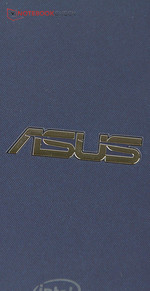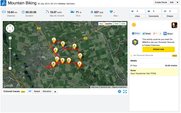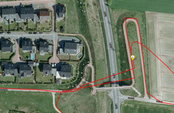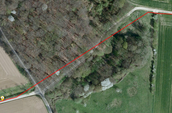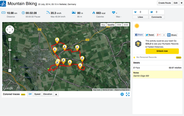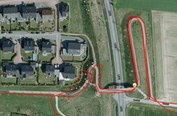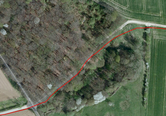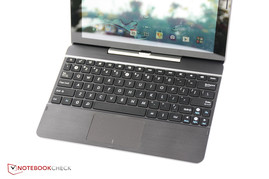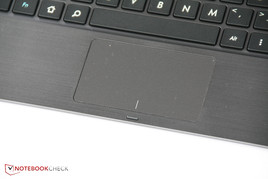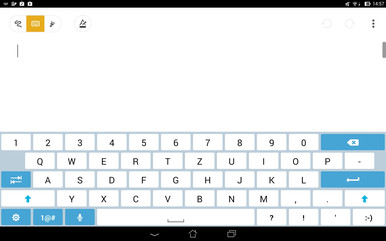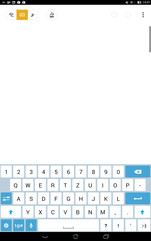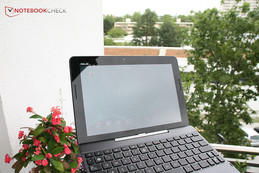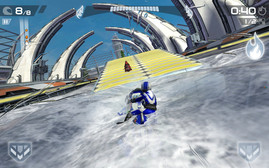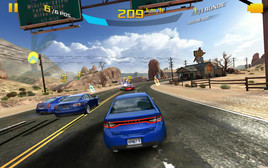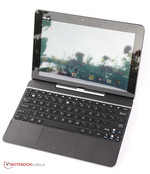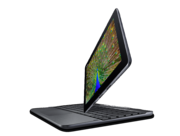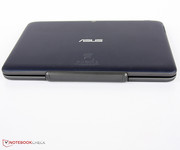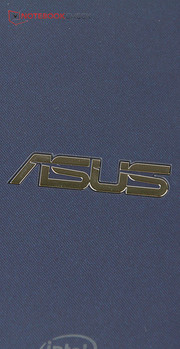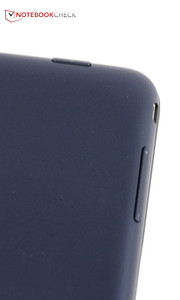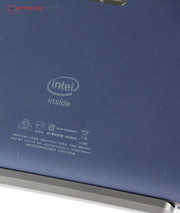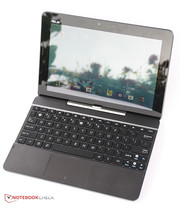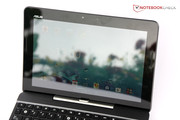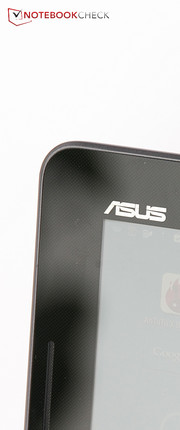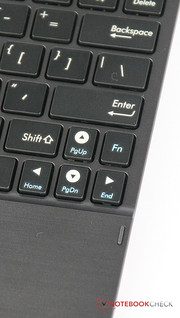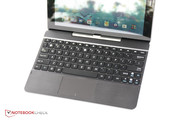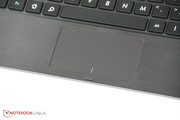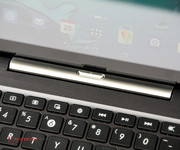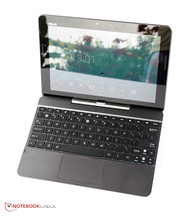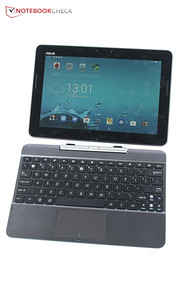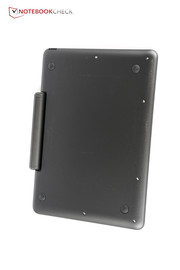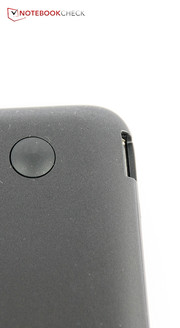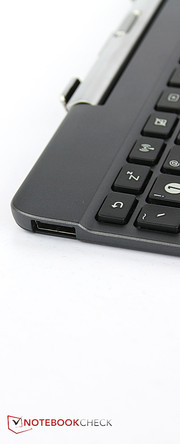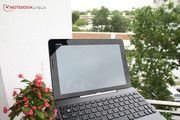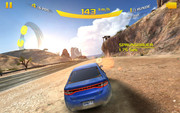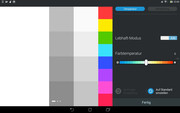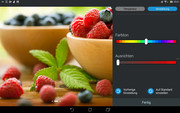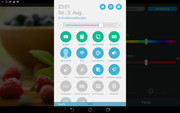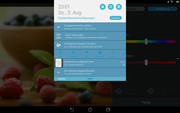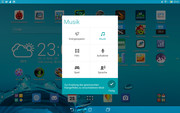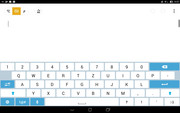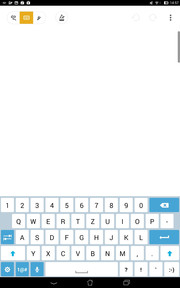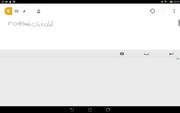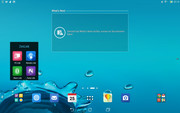Asus Transformer Pad TF303CL-1D050A Tablet Review

For the original German review, see here.
Do you find the lack of a keyboard in a tablet annoying? But then again, a laptop is often too heavy and too unhandy? In that case, Asus offers an interesting hybrid with its Transformer Pad line. Full-fledged tablets that turn into small laptops via a keyboard dock. We recently tested the Transformer Pad TF103C, and it surprised us very positively. We only found it too bad that it no longer had an additional battery in the keyboard dock. Earlier models and some other contenders extend the tablets battery runtime that way.
We are now taking a closer look at the Transformer Pad TF303CL-1D050A, which may be considered to be the luxury version of the TF103C, and which has quite a bit to offer: a soft-touch surface on the tablet, mobile Internet, Full HD screen, micro-HDMI port, and a higher capacity battery than the less well-equipped Transformer Pad TF103C. Asus' decision to now offer the Transformer Pad line with or optionally without a keyboard dock as a pure tablet but is then still called Transformer Pad seems a bit strange. Be that as it may, it is still naturally possible to insert a keyboard dock. The Pad alone costs 399 Euros (~$535), and Asus demands 449 Euros (~$602) for the bundle with keyboard dock. If you don't need LTE, you can save 50 Euros (~$67) in each case. The TF103C costs 299 Euros (~$401) with dock.
We analyze the differences to the TF103C and the even higher-quality TF701T, and also examine to what extent the review sample has been modified compared with earlier models of the product line, for example, TF300T. Contenders from other manufacturers are, for example, HP's SlateBook x2, Lenovo's Yoga Tablet 10 HD+ or Lenovo's Miix 2. Samsung's Galaxy Tab 4 10.1, Acer's Iconia W510 or Dell's XPS 11 would also come into question.
Case
"Let's take black, gray, and maybe white as well. That fits in every environment and won't hurt anyone" - is probably how most conversations run when the big manufacturers of electronic devices talk about casing colors. This discussion was a bit different at Asus, at least in the case of the Transformer Pad TF303CL: blue and gold as the only colors for a device truly cannot be called "classic." Okay, the blue color is quite dark, and the keyboard dock is either silver with white keys in the gold-colored version, or black with a silver-colored hinge like in our case.
Except for the metal hinge, the casing's material is mainly plastic. However, the plastic has a pleasant-to-touch and quality feel, and the keyboard's frame is made in a brushed metal look. The tablet's back is the big highlight though. The soft-touch surface with a light honeycomb texture has a very high-quality feel and a non-slip grip. A minor drawback of the soft-touch surface is that fingerprints quickly accumulate on it just like on the touchscreen. Although the latter has a grease-resistant finish, it cannot completely avert fingerprints.
The build is appealing. The soft-touch surface and display bezel merge without noticeable gaps, and the keyboard dock looks like it has been made of one piece although it is comprised of two parts. The stiffness is also good. The tablet defies pressure from the back well. Although light image errors are visible on the screen, the user will always have the feeling that they are holding a compact and solid device that does not produce any cracking noises.
Although the tablet is certainly not the lightest of its kind on the market with a weight of 595 grams, it is still 40 grams lighter than its TF300T precursor that did not provide a WWAN module in the review sample at the time. The weight increases to 1.145 kilograms with the keyboard dock, which is still light enough to carry the Transformer Pad TF3030CL around in a bag.
Connectivity
Buyers who are intending to opt against the Transformer Pad TF103C for performance reasons, and thus turn to the more expensive TF303CL model might rethink their decision when looking at the configuration specs. Of course, the working memory of 2048 MB is twice as big, but the SoC is the same: Intel's Atom Z3745 with 1.33 GHz. That was enough for a good system performance in the TF103C. Besides that, the TF303CL offers a 16 GB storage capacity, and a version with 32 GB is also available. The storage can be extended via a micro-SD card.
The keyboard dock sports a full-sized USB 2.0 port that enables connecting external hard drives or a mouse without an adapter. The tablet itself has a micro-USB port and also a micro-HDMI port for connecting external monitors this time. However, the keyboard dock does not have a battery, which we already criticized in the Transformer Pad TF103C. The older TF300T still had one that massively increased the battery capacity. Another minor drawback: Compared with the TF300T, the audio jacks have been fused to one single combo jack currently popular among the manufacturers. Consequently, high-quality headsets with dedicated plugs cannot be connected; however, a cell-phone headset can be used.
Overall, the TF303CL offers a considerably better configuration than the TF103C and straightens out a few nicks that we criticized in the less pricey sister model: A higher working memory capacity, an HDMI out, as well as more storage capacity when desired are now available.
Software
The TF103C and our review sample are very identical here: The operating system is based on Android 4.4, which Asus covers with its interface dubbed "ZenUI." Major modifications have not been made in the operating system's core; it is usually graphics details that are different.
The included software is also largely the same as in the less pricey sister model. Some very useful apps that, for example, allow advanced configuring of the on-screen display or the tablet's sound (more about that in the corresponding sections). Vain personalities will like the mirror app that basically turns on the front-facing camera, but which is nevertheless a fun idea. "Party Link" allows connecting to nearby devices easily and quickly for taking pictures at a party and sharing them with all linked devices there.
A picture story comprised of taken and saved pictures can be created with "Story," and "What's Next" collects information from diverse apps and generates a virtual scheduler. For example, the app reminds the user to take an umbrella along when rain is announced for the location of an appointment, or to buy a birthday present for friend in time. So, it is an intelligent calendar that proved to be quite useful and reliable during our tests.
Overall, the software is easy to use, and even newcomers will accommodate quickly. Seasoned Android users will not be confused from the outset and will soon find their way around. However, Windows even in version 8.1 is the considerably more intuitive and more comfortable choice for use with only a mouse and keyboard. More information about "ZenUI" can be found in the overview on Asus' website.
Communication & GPS
The options for connecting to wireless networks are standard: Wi-Fi 802.11 a/b/g/n is available. Half the signal was displayed in a distance of ten meters to the router and through three walls in the non-standardized test. We have seen better results in other devices. At least the website setup was still relatively fast.
The option of ordering the 10.1-inch tablet with an LTE module, like in our review sample, is pleasing. The module transmits in four GPRS bands, four 3G bands and five LTE bands, and it should thus be able to connect to some network anywhere in the world. The reception quality was usually quite good in our tests. We almost always had sufficient reception to browse on the mobile Internet in an urban area. Asus promises a maximum download speed of 150 Mbps and a maximum upload of 50 Mbps for the LTE module. Unfortunately, we could not test the LTE speed due to the insufficient LTE coverage in the German E-Plus network.
The GPS module also supports A-GPS and the Russian GLONASS system. A-GPS is designed to help the satellite-based GPS tracker to make localization even more accurate via the presently active radio cell or tracking via the mobile network. This only functioned to a certain degree with Asus' Transformer Pad TF303CL though. The localization was pretty inaccurate indoors because the satellite signal was practically non-existent according to the "GPS Test" app. The tablet needed quite a long time before it found enough satellites outdoors and only located us with an accuracy of up to 10 meters.
We performed a final test with the tracking module on a short trip with a bike. We used both the review sample and the Garmin Edge 500 navigation system. The recordings of the "Runtastic" app show just how accurately the tracking is: The Transformer Pad TF303CL had problems localizing our path when crossing a bridge and in the woods. The Garmin Edge 500 was considerably more accurate here.
Cameras & Multimedia
Unlike in the dawn of tablets, when only poor quality cameras if any at all were installed, more and more people are seen now using tablets to take pictures. The camera quality is still remote from smartphones, but they have become quite acceptable. The picture quality of the Transformer Pad TF303CL does not exceed "acceptable" - but more about that in a moment. First we will look at the specs: The rear-facing camera has a resolution of 5 megapixels, which corresponds to the 4:3 aspect ratio of 2560x1920 pixels. It is supported by an autofocus but does not have an LED flash. A second camera with a maximum resolution of 1280x960 pixels is on the front.
The pictures of the rear-facing camera are characterized by a slightly artificial-looking color reproduction and the tendency to summarize larger areas to one single-colored layer lacking details. The edges look blurry, and bright areas are quickly overexposed. The camera usually brightens everything quite well in poor light conditions but then tends to color noise and even stronger blurriness. The pictures of the front-facing camera resemble the unfocused TV pictures from the early '80s. However, they are still just sufficient for its main purpose of shooting selfies for social networks and video conferencing.
Accessories
Special accessories are not included for the Transformer Pad TF303CL, apart from the optionally available keyboard dock. In Asus' shop, there are two accessories that might be especially interesting when the tablet is taken along without the keyboard dock: The "Trans Cover" is a flexible cover that can also be used as a tablet stand and naturally protects the screen. It is sold for 39 Euros (~$52). The "Mag Smart Cover" is slightly more rigid and not quite as flexible, and it also costs 39 Euros (~$52).
Warranty
Asus includes a 24-month warranty on the Transformer Pad TF303CL, but some warranty upgrades can be found in Asus' shop. Upgrading to a three-year international service is the most expensive. It makes warranty claims in many countries possible when travelling and costs 99 Euros (~$132). Buyers who only want a local warranty upgrade for an additional year will have to pay 69 Euros (~$92).
Input Devices & Controls
Anyone who has ever held the Transformer Pad TF103C in their hands will recognize the keyboard again. It is the same model. As mentioned, we prefer using a mouse and keyboard with Windows. Nevertheless, the keyboard in the dock is naturally very convenient when typing longer texts. Besides that, its many additional keys, such as standby, settings or home, help navigating.
The keys are spaced with a gap of only 2 millimeters, which is a bit too small for larger hands in conjunction with the standard keys' relatively small dimension of 12 x 13.4 millimeters. The casing's width has been well utilized, but purists may say that some special keys could have been omitted in favor of slightly larger keys. Hands often seem somewhat cramped on the keyboard this way.
Like in the TF103C, our review sample features an American keyboard layout. Naturally, the models sold in Germany will be delivered with a German keyboard layout. Compared with a higher-quality keyboard, the keys have a short drop. However, the drop is still acceptable compared with other devices from the same category. In any case, it supports fast and comfortable typing more than the lacking feedback via key stroke. However, the keyboard is fairly quiet.
The on-screen keyboard that Asus has modified also looks a bit cramped at first glance. However, it exemplary has a vast amount of settings that allows adapting the keys' height among other things. Word suggestions and the option of a bilingual keyboard are just as much an option as speech input. Unfortunately, handwritten entries are only possible with special apps.
Of course, the ClickPad is not really big due to the casing's small size, but it features a pleasant surface that is quite sleek. The keys are still quite loud, but measured on the standards of a ClickPad, working is pretty accurate. Even drag and drop usually functions quite well. However, multi-touch gestures like zoom and scroll are not always detected correctly.
Although the capacitive touchscreen doesn't have a Gorilla Glass surface, it still features a pleasantly sleek plastic pane. The touch-sensitive surface is accurate into the outermost corners and responds quickly. Multi-touch also functions here considerably more accurately.
Display
Whether or not a Full HD screen makes any sense in a 10.1-inch screen size is debatable. The fact is that Asus' Transformer Pad TF303CL provides very sharp pictures with that resolution. The screen features, like the majority of touchscreens, a glossy finish so that issues in outdoor use are very likely to evolve. The Full HD screen is one difference to the TF103C that had a resolution of only 1280x800 pixels.
The less expensive device has the lead in brightness though. The IPS screen in the TF303CL only just manages an average of 202.8 cd/m²; the screen in the TF103C accomplishes twice as much! The illumination of 80% in our present review sample is also not as homogeneous; brightness differences are quite visible to the naked eye on large, white surfaces.
| |||||||||||||||||||||||||
Brightness Distribution: 80 %
Center on Battery: 222 cd/m²
Contrast: 766:1 (Black: 0.29 cd/m²)
ΔE ColorChecker Calman: 7.95 | ∀{0.5-29.43 Ø4.78}
ΔE Greyscale Calman: 8.46 | ∀{0.09-98 Ø5}
Gamma: 3.24
CCT: 6068 K
Although the black level of 0.29 cd/m² is much lower than that of the TF103C, the contrast of the screen in the TF303CL does not reach that of its little brother's. 766:1 is not a bad rate though. The color reproduction for an IPS screen with a glossy finish is a bit pale. However, the transformer Pad TF303CL has an ace up its sleeve: the app "Splendid" that allows setting the screen's color reproduction in detail and according to personal preferences. Even black and white operation would be theoretically possible with it.
We examined the screen closer with CalMAN software and a special instrument in order to collect more detailed values about color reproduction. We measured using the state of delivery settings and ascertained that the color reproduction is in fact too pale. The colors are lightly shifted toward green, while the saturation of blue colors is clearly over-saturated, and red and green colors are under-saturated. Overall, the color reproduction deviates strongly from the ideal value of the reference color space.
The TF303CL does a much poorer job outdoors than the TF103C, which is simply due to the considerably lower brightness. Barely anything can be seen on either device in direct sunlight anyway. However, it gets difficult to recognize something on the TF303CL even under cloudy skies or in the shade depending on the background. The TF103C could still be used to some extent here.
The viewing angles of the IPS screen do not give much reason for complaint. The image only dims slightly when the viewing angles from above or below are changed. No changes are visible for a long time from the left or right. The image remains well recognizable from all sides even from very flat viewing angles.
Performance
As mentioned, the performance differences between the TF103C and TF303CL are more marginal because the same SoC is used. The larger working memory of 2048 MB, however, results in a considerably more relaxed working sensation. Unlike the TF103C where only just over 300 MB of working memory was available even when apps were not running in the background, our review sample has 1 GB. The chance that apps do not start due to too little working memory thus decreases drastically.
The SoC comes from Intel, is called Atom Z3745, has four cores, and it can boost its base clock of 1.33 GHz up to 1.86 GHz. Consequently, the TF103C left many contenders behind, and even the TF303CL secures itself one of the top ranks when compared in the synthetic benchmarks. Even HP's SlateBook x2 with a much higher clocked Nvidia Tegra 4 SoC cannot achieve a really big lead overall. However, Dell's XPS 11 with Intel's Core i5-4210Y can clearly set itself apart, but it is ultimately a small x86 processor and the device is almost twice as expensive as our review sample.
A graphics unit integrated into the SoC is responsible for graphics calculations and bears the simple name Intel HD Graphics. It clearly outperforms Qualcomm's Adreno 305 in both Samsung's Galaxy Tab 4 and Lenovo's Yoga Tablet 10 and provides 50 to 83% more power depending on the benchmark. The Transformer Pad TF701T has a slight lead, which is not surprising since its SoC comes from the graphics expert Nvidia. Overall, the graphics performance should even be enough for more demanding games from Google's Play Store. We will examine that under "Games" further below.
| 3DMark - 1280x720 offscreen Ice Storm Unlimited Score (sort by value) | |
| Asus Transformer Pad TF303CL-1D050A | |
| Asus Transformer Pad TF103C-1B072A | |
| Asus Transformer Pad TF701T | |
| Lenovo Yoga Tablet 10 HD+ | |
| Samsung Galaxy Tab 4 10.1 | |
| GFXBench 3.0 | |
| on screen Manhattan Onscreen OGL (sort by value) | |
| Asus Transformer Pad TF303CL-1D050A | |
| Asus Transformer Pad TF701T | |
| Lenovo Yoga Tablet 10 HD+ | |
| Samsung Galaxy Tab 4 10.1 | |
| 1920x1080 1080p Manhattan Offscreen (sort by value) | |
| Asus Transformer Pad TF303CL-1D050A | |
| Asus Transformer Pad TF701T | |
| Lenovo Yoga Tablet 10 HD+ | |
| Samsung Galaxy Tab 4 10.1 | |
Internet browsing is smooth in practice, and even intricate HTML5 pages with many animations are presented smoothly. The synthetic browser benchmark where Asus' Transformer Pad TF303CL is not always first place, but is at least in the upper midfield, confirms this impression.
| Peacekeeper - --- (sort by value) | |
| Asus Transformer Pad TF303CL-1D050A | |
| Asus Transformer Pad TF701T | |
| HP SlateBook x2 | |
| Lenovo Yoga Tablet 10 HD+ | |
| Dell XPS 11 | |
| Browsermark - 2.1 (sort by value) | |
| Asus Transformer Pad TF303CL-1D050A | |
| Lenovo Yoga Tablet 10 HD+ | |
| Lenovo Miix 2 10 | |
| Samsung Galaxy Tab 4 10.1 | |
| Octane V2 - Total Score (sort by value) | |
| Asus Transformer Pad TF303CL-1D050A | |
| Asus Transformer Pad TF701T | |
| Lenovo Yoga Tablet 10 HD+ | |
| Samsung Galaxy Tab 4 10.1 | |
The eMMC storage in the Transformer Pad TF303CL can be ordered with a capacity of 16 or 32 GB. Our review sample features 16 GB that does not work quite as fast as in the TF103C. Even the storage in other devices like Lenovo's Yoga Tablet 10 HD+ or Samsung's Galaxy Tab 4 10.1 transfer data considerably faster.
However, we did not notice any unusually long booting times or lags caused by storage accessing in practical use. Data transfer might be a bit slower though.
Games
As mentioned, Intel's HD Graphics with a base clock of 311 MHz and a Turbo clock of up to 896 MHz can outperform most graphics solutions integrated into other SoCs. That is also noticed in games from Google's Play Store.
Emissions
Temperature
The Transformer Pad TF303CL already gets warmer than the TF103C when idling. Apparently, the Full HD screen stresses the graphics unit quite strongly. In any case, the surface also reaches a considerably higher temperature than the TF103C during load. We measured a maximum of 38.8 °C on our review sample's back right. That is not yet a critical temperature, but it is noticeably warm. Overall, we cannot complain about the TF303CL's temperature development; it stays very much within limits, especially when considering the system's comparatively high performance.
(+) The maximum temperature on the upper side is 34.8 °C / 95 F, compared to the average of 33.7 °C / 93 F, ranging from 20.7 to 53.2 °C for the class Tablet.
(+) The bottom heats up to a maximum of 38.8 °C / 102 F, compared to the average of 33.2 °C / 92 F
(+) In idle usage, the average temperature for the upper side is 30.8 °C / 87 F, compared to the device average of 30 °C / 86 F.
Speakers
Compared with the TF103C, the speakers have been moved from the tablet's back to the front, but are on the same level beside the screen. This should result in a considerably better sound because the speakers face the user. However, we only ascertained very slight differences in a direct comparison.
The speakers are still quite good for a tablet, but they tend to hum marginally in maximum volume and are then no longer particularly differentiated in terms of sound from several, simultaneously playing instruments. Music pieces that involve only one singer and few instruments are rendered clearly, and even a hint of bass can be heard.
Music fans will likely be happier with external speakers. As said, they can be only connected via the combo-audio port. It, however, delivers a decent sound quality.
Energy Management
Power Consumption
The TF303CL's power consumption is clearly higher than that of the TF103C in almost all categories. How can that be seeing that both use the same SoC? Android identifies the screen as the biggest energy guzzler. The power consumption is likely higher despite the lower maximum brightness. It might also be due to the fact that the calculations for a Full HD screen are more complex for the graphics unit than the image of a 1280x800 pixel screen like the TF103C can display at most. The Transformer Pad TF303CL's power consumption is also higher than that of other 10.1-inch tablets. Lenovo's Yoga Tablet 10 HD+ and Samsung's Galaxy Tab 4 10.1 are both considerably more frugal.
Our review sample consumes an average of 4.6 watts in idle mode, i.e. when the system is not loaded. A maximum possible consumption of 8.1 watts is possible during load. However, this rate should hardly ever be reached, and the medium load consumption of 7.5 watts will be the rule. The battery in the TF303CL is bigger than that of the TF103C, but it will nevertheless be interesting to see how the significantly higher consumption will affect the runtimes.
| Off / Standby | |
| Idle | |
| Load |
|
Key:
min: | |
Battery Runtime
The battery of the Transformer Pad TF303CL can provide 25 watt hours. That is 6 watt hours more than the TF103C. However, our review sample does not reach the runtimes of its little brother due to its much higher consumption.
Although the runtimes are suitable in practice with 7:05 hours in the practical Wi-Fi test and 6:31 hours when watching movies, they are only midfield in total. HP's SlateBook x2 or Lenovo's Miix 2 do not achieve that, unlike Samsung's Galaxy Tab 4 10.1 or Lenovo's Yoga Tablet 10 HD+ that last considerably longer.
Verdict
The Transformer Pad TF303CL offers a lot of things that we would have liked to see in the TF103C: an HDMI port, a bigger battery, a Full HD screen, and a larger working memory. The same SoC is used as in the less well-equipped TF103C, and thus the performance of both devices is on par seen only technically, whereas the TF103C has the faster storage device. The cameras in the TF303CL are considerably more useful than those in the TF103C, but their quality is still far remote from good smartphone cameras.
However, despite the great joy about the superior configuration, some things did come too short. For example, the screen's brightness is now much lower, the power consumption is considerably higher, and the GPS module is less accurate and slower. The input devices in the keyboard dock are quite a useful and sensible extension. Users who have big hands and type a lot will not be happy with the cramped keyboard though.
Overall, the TF303CL is definitely worth the surcharge in comparison with its less well-equipped brother. However, it should not be expected that everything has improved. The TF303CL is primarily suitable for indoor use because of its dark screen. It is nice to look at and well built. It will prove right when you are looking for a highly flexible, compact device with high performance and practical battery runtimes. The device will be available in retail as of September.
If you are not reliant on the high resolution and can live without the HDMI port, you can save money with the TF103C. It also includes a brighter screen and even longer battery runtimes.




